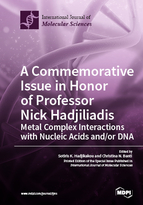A Commemorative Issue in Honor of Professor Nick Hadjiliadis: Metal Complex Interactions with Nucleic Acids and/or DNA
A special issue of International Journal of Molecular Sciences (ISSN 1422-0067). This special issue belongs to the section "Bioinorganic Chemistry".
Deadline for manuscript submissions: closed (31 May 2018) | Viewed by 65669
Special Issue Editors
Interests: bioinorganic chemistry; evaluation of the anticancer properties of metal complexes by studying their interaction with intracellular molecules
Special Issues, Collections and Topics in MDPI journals
Interests: crystal structure; structure determination; material characterization; structural chemistry; biological inorganic chemistry, antimicrobial compounds; antiproliferative compounds
Special Issues, Collections and Topics in MDPI journals
Special Issue Information
Dear Colleagues,
This special issue entitled "Metal complexes interactions with Nucleic acids and/or DNA" was inspired by Prof. Sotiris Hadjikakou, due to the contribution of Prof. Nick Hadjiliadis in the field of palladium or/and platinum/nucleic acids interactions. It will cover a selection of recent research and review articles in the field of Metal complexes interactions with Nucleic acids and/or DNA.
Metal complexes have long been recognized as critically important components of nucleic acid chemistry, both in regulation of gene expression and as promising therapeutic agents. The ability to recognize, to understand at the molecular level of how metal complexes interact with DNA has become an active research area at the interface between biological inorganic chemistry, molecular biology and medicine.
Arguably, the most prominent drug which contains a metal is cisplatin, the most widely used anti-cancer drug. The success of cisplatin in chemotherapy and the clarification of its mechanism of action through interaction with DNA has motivated a large number of studies on metal complexes interaction with nucleic acids or/and DNA. From the foregoing that the reader of this special issue will gain an appreciation of the real role of the interactions of metal complexes with nucleic acids or/and DNA in modern medicine.
This special issue on the "Metal complexes interactions with Nucleic acids and/or DNA" aims to provide an overview of this increasingly diverse field, presenting recent developments and the latest research with particular emphasis on metal-based drugs and metal ion toxicity.
Prof. Dr. Sotiris Hadjikakou
Dr. Christina N. Banti
Guest Editors
Manuscript Submission Information
Manuscripts should be submitted online at www.mdpi.com by registering and logging in to this website. Once you are registered, click here to go to the submission form. Manuscripts can be submitted until the deadline. All submissions that pass pre-check are peer-reviewed. Accepted papers will be published continuously in the journal (as soon as accepted) and will be listed together on the special issue website. Research articles, review articles as well as short communications are invited. For planned papers, a title and short abstract (about 100 words) can be sent to the Editorial Office for announcement on this website.
Submitted manuscripts should not have been published previously, nor be under consideration for publication elsewhere (except conference proceedings papers). All manuscripts are thoroughly refereed through a single-blind peer-review process. A guide for authors and other relevant information for submission of manuscripts is available on the Instructions for Authors page. International Journal of Molecular Sciences is an international peer-reviewed open access semimonthly journal published by MDPI.
Please visit the Instructions for Authors page before submitting a manuscript. There is an Article Processing Charge (APC) for publication in this open access journal. For details about the APC please see here. Submitted papers should be well formatted and use good English. Authors may use MDPI's English editing service prior to publication or during author revisions.
Keywords
- Biological inorganic chemistry
- Metal complexes interactions with nucleic acids
- Metal complexes interactions with DNA
- Metal-based drugs
- Platinum complexes anticancer agents
- Non-platinum metal complexes anticancer agents








